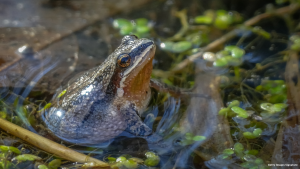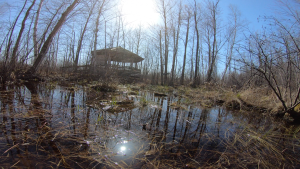by Ty Fischer, Riparian Health Restoration Intern
In conservation biology, the term “charismatic megafauna” refers to the largest and most iconic species of animal, such as wolves and grizzly bears, for which threats to their population status attract a disproportionate amount of the public’s attention (Krause, Robinson, 2017).
Historically, these species were the core focus of conservation efforts because the ubiquitous appreciation for them could be used as a driving force to motivate the public to care about broader issues. However, a consequence of this was that the needs of more unique and smaller species fell by the wayside and were addressed only if they happened to be in-line with other conservation goals. Fortunately now conservation efforts are focusing more on an ecosystem-wide scale, recognizing that biodiversity across all forms of life is the very thing that makes our natural ecosystems so resilient, vibrant, and beautiful. As a result, more of the issues facing these smaller species now attract our attention as these species receive as much care as would be afforded to the charismatic megafauna in our world.
If you need evidence of this shift in our valuing of more unassuming species, look no further than the Western Chorus Frog (Pseudacris triseriata). Despite only reaching up to 2.5cm long and weighing 1g when fully grown, this little tree frog has been making headlines recently. This is because their Great Lakes/St. Lawrence – Canadian Shield (GLSLCS) population has been facing ongoing threats as a result of increased residential, commercial, and industrial developments, despite the species been listed as “Threatened” under Schedule 1 of the Species at Risk Act (SARA) since 2010. Within the past decade, populations in Quebec and Ontario have declined by 37% and 30%, respectively, and projected future reductions in their numbers are on the horizon (COSEWIC, 2008). Climate change adds another level of uncertainty as warmer temperatures can start causing the temporary vernal ponds that the Western Chorus Frog breeds in to dry up more quickly (Bonin and Galois 1996; Barnett et al. 2005).

A Western Chorus Frog (Pseudacris triseriata).
Apart from climate change, one of the most significant risks that these frogs face is habitat loss and degradation. This is an especially prominent issue around waterfront, wetland, and wooded properties, in which the natural vegetation is often replaced with manicured lawns, hardened shoreline structures, and other artificially produced landscape features. Such changes disturb or completely remove the land-water interface that is so vital for species like the Western Chorus Frog, Eastern Red-Backed Salamander, and many more. Even in areas where suitable conditions remain, the fragmented habitat can leave Western Chorus Frog populations isolated and thereby more susceptible to local extinction (Hanski et al., 2015). This is not to mention the other negative effects of urbanization, which include increased sedimentation and pollution, changes to the natural hydrology via soil permeability and drainage, and invasion by foreign species to name a few (Hamer and McDonnell, 2008).
Spanning much of Southern Ontario and Quebec, the GLSLCS population of the Western Chorus Frog occupies such an extensive geographical range that the way to address these issues is not for a few people to make big changes, but rather for many people to make a few small changes. Of especially high importance is the actions of shoreline property owners who often hold the deeds to riparian habitat health and connectivity. With improvements to their shoreline property, such as restoring and maintaining a wide buffer of native plants along the edge of the water (as advocated by the program, The Natural Edge), or implementing runoff-absorbing pathways and low-impact docks (as advocated by the program, Love Your Lake), waterfront residents can simultaneously establish critical habitat and improve water quality. Moreover, when these positive impacts are combined and multiplied across all the shoreline properties in the Western Chorus Frog’s GLSLCS range, this will undoubtedly make a tangible difference in the long-term population status of this species.

A vernal pool located next to a forest and wetland.
It is important to remember here that this species is serving as our “charismatic microfauna”, so to speak. Like wolves and grizzly bears were in the past, the Western Chorus Frog is an indicator of all the harms that our native species face, and they join the chorus (no pun intended) of countless other flora and fauna that will benefit from the responsible and informed use of our waterways and the surrounding shorelands. Waterfront property owners are on the front lines of maintaining this freshwater health, but of course everyone can help spread awareness about such issues and their solutions – we just need to keep talking about them.
References
Barnett, T. P., Adam, J. C., & Lettenmaier, D. P. (2005). Potential impacts of a warming climate on water availability in snow-dominated regions. Nature, 438(7066), 303–309. https://doi.org/10.1038/nature04141
Bonin, J. & Galois, P. (1996) Rapport sur la situation de la rainette faux-grillon (Pseudacris triseriata) au Québec. Ministère de l’Environnement et de la Faune, Direction de la faune et des habitats, Quebec, 39 pp.
COSEWIC (2008). COSEWIC assessment and update status report on the Western Chorus Frog Pseudacris triseriata Carolinian population and Great Lakes/St. Lawrence – Canadian Shield population in Canada. Committee on the Status of Endangered Wildlife in Canada. Ottawa.vii + 47 pp.
Hamer, A. J., & McDonnell, M. J. (2008). Amphibian ecology and conservation in the Urbanising World: A Review. Biological Conservation, 141(10), 2432–2449. https://doi.org/10.1016/j.biocon.2008.07.020
Hanski, I., Pakkala, T., Kuussaari, M., & Lei, G. (1995). Metapopulation persistence of an endangered butterfly in a fragmented landscape. Oikos, 72(1), 21. https://doi.org/10.2307/3546033
Krause, M., & Robinson, K. (2017). Charismatic species and beyond: How cultural schemas and organisational routines shape conservation. Conservation and Society, 15(3), 313. https://doi.org/10.4103/cs.cs_16_63
